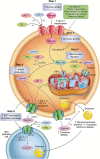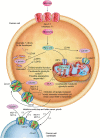Reexamining cancer metabolism: lactate production for carcinogenesis could be the purpose and explanation of the Warburg Effect
- PMID: 27993896
- PMCID: PMC5862360
- DOI: 10.1093/carcin/bgw127
Reexamining cancer metabolism: lactate production for carcinogenesis could be the purpose and explanation of the Warburg Effect
Abstract
Herein, we use lessons learned in exercise physiology and metabolism to propose that augmented lactate production ('lactagenesis'), initiated by gene mutations, is the reason and purpose of the Warburg Effect and that dysregulated lactate metabolism and signaling are the key elements in carcinogenesis. Lactate-producing ('lactagenic') cancer cells are characterized by increased aerobic glycolysis and excessive lactate formation, a phenomenon described by Otto Warburg 93 years ago, which still remains unexplained. After a hiatus of several decades, interest in lactate as a player in cancer has been renewed. In normal physiology, lactate, the obligatory product of glycolysis, is an important metabolic fuel energy source, the most important gluconeogenic precursor, and a signaling molecule (i.e. a 'lactormone') with major regulatory properties. In lactagenic cancers, oncogenes and tumor suppressor mutations behave in a highly orchestrated manner, apparently with the purpose of increasing glucose utilization for lactagenesis purposes and lactate exchange between, within and among cells. Five main steps are identified (i) increased glucose uptake, (ii) increased glycolytic enzyme expression and activity, (iii) decreased mitochondrial function, (iv) increased lactate production, accumulation and release and (v) upregulation of monocarboxylate transporters MTC1 and MCT4 for lactate exchange. Lactate is probably the only metabolic compound involved and necessary in all main sequela for carcinogenesis, specifically: angiogenesis, immune escape, cell migration, metastasis and self-sufficient metabolism. We hypothesize that lactagenesis for carcinogenesis is the explanation and purpose of the Warburg Effect. Accordingly, therapies to limit lactate exchange and signaling within and among cancer cells should be priorities for discovery.
© The Author 2016. Published by Oxford University Press.
Figures




Similar articles
-
The Warburg effect: essential part of metabolic reprogramming and central contributor to cancer progression.Int J Radiat Biol. 2019 Jul;95(7):912-919. doi: 10.1080/09553002.2019.1589653. Epub 2019 Mar 22. Int J Radiat Biol. 2019. PMID: 30822194 Review.
-
The tortuous path of lactate shuttle discovery: From cinders and boards to the lab and ICU.J Sport Health Sci. 2020 Sep;9(5):446-460. doi: 10.1016/j.jshs.2020.02.006. Epub 2020 Feb 21. J Sport Health Sci. 2020. PMID: 32444344 Free PMC article. Review.
-
Multiple biological activities of lactic acid in cancer: influences on tumor growth, angiogenesis and metastasis.Curr Pharm Des. 2012;18(10):1319-30. doi: 10.2174/138161212799504902. Curr Pharm Des. 2012. PMID: 22360558 Review.
-
Tumor microenvironment and metabolic synergy in breast cancers: critical importance of mitochondrial fuels and function.Semin Oncol. 2014 Apr;41(2):195-216. doi: 10.1053/j.seminoncol.2014.03.002. Epub 2014 Mar 5. Semin Oncol. 2014. PMID: 24787293 Review.
-
The Warburg effect in tumor progression: mitochondrial oxidative metabolism as an anti-metastasis mechanism.Cancer Lett. 2015 Jan 28;356(2 Pt A):156-64. doi: 10.1016/j.canlet.2014.04.001. Epub 2014 Apr 13. Cancer Lett. 2015. PMID: 24732809 Free PMC article. Review.
Cited by
-
Offset of apparent hyperpolarized 13 C lactate flux by the use of adjuvant metformin in ionizing radiation therapy in vivo.NMR Biomed. 2021 Aug;34(8):e4561. doi: 10.1002/nbm.4561. Epub 2021 Jun 3. NMR Biomed. 2021. PMID: 34080736 Free PMC article.
-
Role of the Gastric Microbiome in Gastric Cancer: From Carcinogenesis to Treatment.Front Microbiol. 2021 Mar 15;12:641322. doi: 10.3389/fmicb.2021.641322. eCollection 2021. Front Microbiol. 2021. PMID: 33790881 Free PMC article. Review.
-
Clinical and prognostic value of tumor volumetric parameters in melanoma patients undergoing 18F-FDG-PET/CT: a comparison with serologic markers of tumor burden and inflammation.Cancer Imaging. 2020 Jul 6;20(1):44. doi: 10.1186/s40644-020-00322-1. Cancer Imaging. 2020. PMID: 32631431 Free PMC article.
-
Construction of a prognostic signature for serous ovarian cancer based on lactate metabolism-related genes.Front Oncol. 2022 Sep 15;12:967342. doi: 10.3389/fonc.2022.967342. eCollection 2022. Front Oncol. 2022. PMID: 36185201 Free PMC article.
-
Monocarboxylate transporter 4 (MCT4) is a high affinity transporter capable of exporting lactate in high-lactate microenvironments.J Biol Chem. 2019 Dec 27;294(52):20135-20147. doi: 10.1074/jbc.RA119.009093. Epub 2019 Nov 12. J Biol Chem. 2019. PMID: 31719150 Free PMC article.
References
-
- Warburg O., et al. (1923) Versuche an überlebendem carcinom-gewebe. Klin Wochenschr, 2, 776–777.
-
- Warburg O. (1924) Über den stoffwechsel der carcinomzelle. Naturwissenschaften, 12, 1131–1137.
-
- Racker E. (1972) Bioenergetics and the problem of tumor growth: an understanding of the mechanism of the generation and control of biological energy may shed light on the problem of tumor growth. Am. Sci., 60, 56–63. - PubMed
-
- Gillies R.J., et al. (2007) Adaptive landscapes and emergent phenotypes: why do cancers have high glycolysis? J. Bioenerg. Biomembr., 39, 251–257. - PubMed
Publication types
MeSH terms
Substances
LinkOut - more resources
Full Text Sources
Other Literature Sources
Medical

